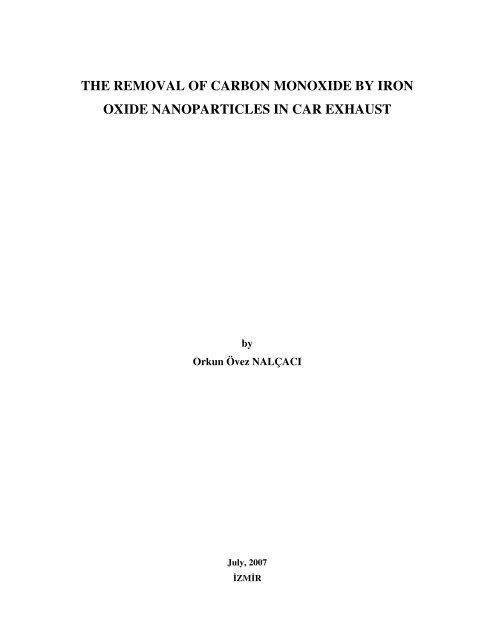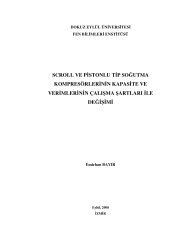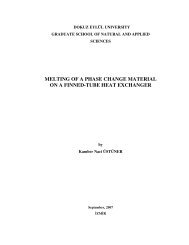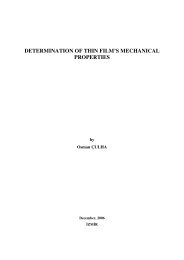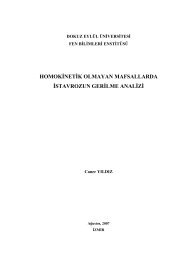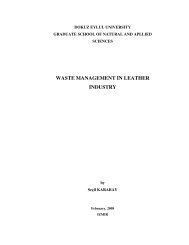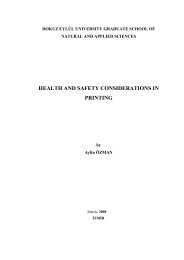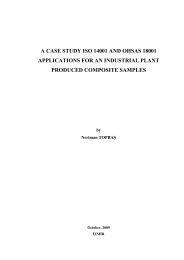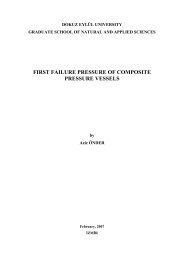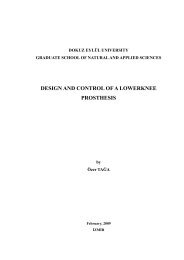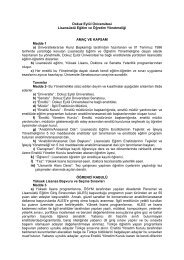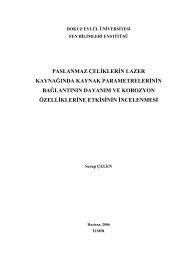the removal of carbon monoxide by iron oxide nanoparticles in car ...
the removal of carbon monoxide by iron oxide nanoparticles in car ...
the removal of carbon monoxide by iron oxide nanoparticles in car ...
You also want an ePaper? Increase the reach of your titles
YUMPU automatically turns print PDFs into web optimized ePapers that Google loves.
THE REMOVAL OF CARBON MONOXIDE BY IRONOXIDE NANOPARTICLES IN CAR EXHAUST<strong>by</strong>Orkun Övez NALÇACIJuly, 2007İZMİR
THE REMOVAL OF CARBON MONOXIDE BY IRON OXIDE NANOPARTICLESIN CAR EXHAUSTABSTRACTThis study focuses on <strong>the</strong> oxidation <strong>of</strong> soot <strong>in</strong> diesel exhaust gases us<strong>in</strong>g Fe 2 O 3 as a modelcatalyst. The purpose is to establish a <strong>the</strong>rmally stable nano-sized Fe 2 O 3 catalyst for use <strong>in</strong>diesel exhaust emissions. Nano-sized Fe 2 O 3 was produced us<strong>in</strong>g sol-gel method. Thesyn<strong>the</strong>sis <strong>of</strong> bulk Fe 2 O 3 was <strong>car</strong>ried out <strong>by</strong> polyv<strong>in</strong>yl alcohol (PVA) technique.Thermogravimetric analysis (TG) and temperature programmed oxidation analysis (TPO)were conducted. The effect <strong>of</strong> various dopants (Zr, Ce, Fe) and <strong>the</strong>rmal ag<strong>in</strong>g were<strong>in</strong>vestigated. Also each sample was analyzed with X-Ray Diffraction (XRD) before and aftereach experiment. Our analysis show that, nano-sized Fe 2 O 3 grants a temperature decrease <strong>in</strong>peak reaction temperature up to nearly 150 ºC.Keywords; Catalysis; Vehicle emissions; Autocatalysts; Nano <strong>iron</strong> <strong>oxide</strong>OTOMOBİL EKSOZUNDAN KARBON MONOKSİTİN NANO DEMİR OKSİTKULLANILARAK AYRIŞTIRILMASIÖZBu çalışma dizel egsoz gazlarındaki is<strong>in</strong> nano demir oksit kullanılarak <strong>in</strong>dirg<strong>in</strong>mesiüzer<strong>in</strong>edir. Amaç dizel motorlu araçların egsoz gazlarında katalist olarak kullanılabilecek ısılolarak stabil bir nano boyutlu demir oksit katalist yaratmaktır. Nano boyutlu demir oksit solgelmethodu ile üretilmiştir. Büyük tanecikli demir oksit ise polyv<strong>in</strong>yl alkol methoduylasentezlenmiştir. Örnekler üzer<strong>in</strong>de <strong>the</strong>rmogravimetrik (TG) ve zaman ayarlı oksidasyon(TPO) analizleri yapılmıştır. Ayrıca ısıl yaşlanmanın ve değişik madde (Zr, Ce, Fe)katkılarının etkileri <strong>in</strong>celenmiştir. Deneylerimiz nano-Fe 2 O 3 <strong>in</strong> 150 ºC lik bir ısıl kazançsağladığını kanıtlamaktadır.Anahtar Kelimeler; Kataliz; Egzos gazları; Araba katalizörleri; Nano <strong>iron</strong> oksit
1. IntroductionWith <strong>the</strong> implementation <strong>of</strong> <strong>car</strong>s <strong>in</strong>to our everyday life, a dangerous aspect <strong>of</strong> this luxurybecame apparent; exhaust gases. The oxidation <strong>of</strong> gasol<strong>in</strong>e <strong>in</strong> <strong>the</strong> eng<strong>in</strong>e to CO 2 and H 2 O isfar from completely efficient. To fight with this problem, various laws and regulations weremade. These emission standards limit <strong>the</strong> maximum amount <strong>of</strong> harmful substances a <strong>car</strong>exhaust can release. The pollutants that are limited today <strong>by</strong> <strong>the</strong>se regulations arehydro<strong><strong>car</strong>bon</strong>s (HC), <strong><strong>car</strong>bon</strong> <strong>mon<strong>oxide</strong></strong> (CO), <strong>oxide</strong>s <strong>of</strong> nitrogen (NO x ) and particulate matter(PM). Advances <strong>in</strong> eng<strong>in</strong>e and vehicle technology cont<strong>in</strong>ually reduce <strong>the</strong> amount <strong>of</strong> pollutantsgenerated, but this is generally considered <strong>in</strong>sufficient to meet emissions goals (Twigg, 2007).Therefore, technologies to react with and clean up <strong>the</strong> rema<strong>in</strong><strong>in</strong>g emissions have long been anessential part <strong>of</strong> emissions control.A characteristic <strong>of</strong> old diesel eng<strong>in</strong>es was ‘‘black soot’’ <strong>in</strong> <strong>the</strong>ir exhausts caused <strong>by</strong> <strong>the</strong>combustion process itself <strong>in</strong> which very small ‘‘atomised’’ droplets <strong>of</strong> fuel burn<strong>in</strong>g <strong>in</strong> hotcompressed air left an unburnt core <strong>of</strong> f<strong>in</strong>e <strong><strong>car</strong>bon</strong> particles onto which o<strong>the</strong>r species <strong>in</strong> <strong>the</strong>exhaust gas, <strong>in</strong>clud<strong>in</strong>g HCs, sulphur compounds NO x and water adsorbed. Recentlytremendous advances were made <strong>in</strong> <strong>the</strong> fuell<strong>in</strong>g and combustion processes <strong>of</strong> modern highspeeddiesel eng<strong>in</strong>es used <strong>in</strong> passenger <strong>car</strong>s. This <strong>in</strong>volved very high pressure pumps, an<strong>in</strong>creased number <strong>of</strong> smaller <strong>in</strong>jector nozzles, and multiple <strong>in</strong>jections. As a result soot orparticulate matter (PM), emissions have been reduced to low levels. Never<strong>the</strong>less, <strong>the</strong>re arestill concerns about <strong>the</strong> possible health effects <strong>of</strong> diesel PM and <strong>the</strong>re is a move to elim<strong>in</strong>atethis <strong>by</strong> filtration (Twigg, 2006).So far three procedures were ma<strong>in</strong>ly exam<strong>in</strong>ed <strong>in</strong> detail; classical selective catalyticreduction (SCR), HC SCR procedure and NO x storage catalyst (NSC) technology,respectively. In case <strong>of</strong> SCR technique, nitrogen <strong>oxide</strong>s are selectively reduced <strong>by</strong> ammonia<strong>in</strong>to nitrogen over TiO 2 supported V 2 O 5 /WO 3 catalysts. The required ammonia can beproduced “on board” <strong>by</strong> decomposition for example <strong>of</strong> urea (Kureti et al., 2003).In <strong>the</strong> HC SCR procedure nitrogen <strong>oxide</strong>s are reduced <strong>by</strong> hydro<strong><strong>car</strong>bon</strong>s over plat<strong>in</strong>umcatalysts. In this process hydro<strong><strong>car</strong>bon</strong>s can be generated from <strong>the</strong> fuel, and <strong>the</strong>refore noadditional tank for its storage is required. However, NO x reduction takes place with smaller
conversion and lower nitrogen selectivity than occurred <strong>by</strong> NH 3 SCR procedure.Fur<strong>the</strong>rmore, large quantities <strong>of</strong> unwanted greenhouse gas N 2 O are also formed.The NSC technology is based upon periodic adsorption and subsequent reduction <strong>of</strong> NO x .These catalysts conta<strong>in</strong> a precious metal component which promotes <strong>the</strong> oxidation <strong>of</strong> NO <strong>in</strong>toNO 2 . The result<strong>in</strong>g NO 2 is <strong>the</strong>n stored <strong>by</strong> basic adsorbents, e.g. Al 2 O 3 and Ba(OH) 2 . When <strong>the</strong>storage capacity is reached, rich exhaust conditions are established momentarily <strong>by</strong> eng<strong>in</strong>emanagement systems. As a result NO x desorbs from <strong>the</strong> adsorbent and is reduced <strong>by</strong> H2, COand HC present over <strong>the</strong> precious metal. However, a serious constra<strong>in</strong>t <strong>of</strong> NSC technique is<strong>the</strong> susceptibility <strong>of</strong> <strong>the</strong> basic adsorbents to sulfur poison<strong>in</strong>g.The emission <strong>of</strong> soot, which is thought to be <strong>car</strong>c<strong>in</strong>ogen, can be dim<strong>in</strong>ished substantially<strong>by</strong> application <strong>of</strong> soot filters, which work efficiently <strong>in</strong> <strong>the</strong> CRT system (cont<strong>in</strong>uouslyregenerat<strong>in</strong>g trap). The CRT technique was developed <strong>by</strong> Johnson Mat<strong>the</strong>y and is actuallyapplied for heavy duty vehicles. The soot is separated on filters and is later on oxidized <strong>by</strong>NO 2 to CO 2 , where<strong>by</strong> NO 2 is reduced <strong>in</strong>to NO. In this process NO 2 is produced <strong>by</strong> oxidation<strong>of</strong> NO <strong>in</strong> <strong>the</strong> exhaust gas over a plat<strong>in</strong>um catalyst. Consider<strong>in</strong>g <strong>the</strong> overall NO x reactions <strong>the</strong>reis no significant <strong>removal</strong> <strong>of</strong> nitrogen <strong>oxide</strong>s. This CRT system shows an excellentperformance dur<strong>in</strong>g a road test over 700,000 km <strong>in</strong> <strong>the</strong> presence <strong>of</strong> ultra-low sulphur dieselfuel. Ano<strong>the</strong>r possibility <strong>of</strong> soot <strong>removal</strong> is <strong>the</strong> use <strong>of</strong> oxidation catalysts, e.g. Cs 2 SO 4 andV 2 O 5 , which accelerate <strong>the</strong> O 2 –soot reaction.A soot filter system fitted as standard equipment <strong>of</strong> diesel passenger <strong>car</strong>s has beendeveloped <strong>by</strong> both PSA Peugeot Citroen and Toyota. The PSA Peugeot Citroen system hasalready been <strong>in</strong>troduced and it comprises a particle filter that is l<strong>in</strong>ked with a pre-catalyst, i.e.an oxidation catalyst. The filter is discont<strong>in</strong>uously regenerated <strong>by</strong> temperature rise caused <strong>by</strong>post-<strong>in</strong>jection <strong>of</strong> fuel as well as oxidation <strong>of</strong> <strong>the</strong> result<strong>in</strong>g unburnt hydro<strong><strong>car</strong>bon</strong>s over <strong>the</strong>catalyst. The ignition temperature <strong>of</strong> <strong>the</strong> soot is lowered <strong>by</strong> a cerium conta<strong>in</strong><strong>in</strong>g fuel additive.The diesel particulate NO x reduction (DPNR) technique provided <strong>by</strong> Toyota is based upon afilter system that conta<strong>in</strong>s an oxygen releas<strong>in</strong>g agent as well as a NSC. By post-<strong>in</strong>jectionmolecular oxygen and oxygen radicals desorb from <strong>the</strong> oxygen adsorbent and promoteoxidation <strong>of</strong> <strong>the</strong> soot. Fur<strong>the</strong>rmore, <strong>the</strong> precious metal <strong>of</strong> <strong>the</strong> NSC component supports NOoxidation <strong>in</strong>to NO 2 lead<strong>in</strong>g to a cont<strong>in</strong>uous soot oxidation like <strong>in</strong> <strong>the</strong> CRT system.
105700100600500Mass (% )95901 Ce0,1 Ce0,01 CeNano Fe2O3Temperature400300200Tem perature (C)851008000 10 20 30 40 50 60 70Time (m<strong>in</strong>)Figure 1.b The <strong>the</strong>rmogravimetric analysis relative to Ce dopant105700100600500Mass (% )95901 Fe0,1 Fe0,01 FeNano Fe2O3Temperature400300200Tem perature (C)85100800 10 20 30 40 50 60 700Time (m<strong>in</strong>)Figure 1.c The <strong>the</strong>rmogravimetric analysis relative to Fe dopant
Figure 1.a, b and c shows <strong>the</strong> results relative to dopants. All samples show an <strong>in</strong>creas<strong>in</strong>gmass reduction, with <strong>the</strong> <strong>in</strong>crease <strong>in</strong> dopant concentration. O<strong>the</strong>r than this obvious result it isquite hard to comment on <strong>the</strong> results. Reduction <strong>of</strong> <strong><strong>car</strong>bon</strong> <strong>mon<strong>oxide</strong></strong> is <strong>the</strong> prime factor weare <strong>in</strong>vestigat<strong>in</strong>g, however s<strong>in</strong>ce each sample shows two or three different slopes, it is hard todeterm<strong>in</strong>e <strong>the</strong> start and <strong>the</strong> end po<strong>in</strong>ts <strong>of</strong> <strong>the</strong> process. The first slope is probably <strong>the</strong> desorption<strong>of</strong> water (molecular) present on <strong>the</strong> catalyst and <strong>the</strong> second step is dehydroxidation <strong>of</strong> surfaceOH groups. The rema<strong>in</strong>der <strong>of</strong> <strong>the</strong> slopes could be related to different materials that has beenpresent <strong>in</strong>side <strong>the</strong> nano sized Fe 2 O 3 or <strong>the</strong>y could be <strong>the</strong> result <strong>of</strong> rema<strong>in</strong><strong>in</strong>g nitrate particlesthat has not been completely calc<strong>in</strong>ated.To sum up <strong>the</strong> results show various mass reductions which can not be separated from eacho<strong>the</strong>r clearly, which leads to uncerta<strong>in</strong>ty <strong>in</strong> determ<strong>in</strong><strong>in</strong>g where <strong>the</strong> important soot oxidationoccurs.3.2 TPO AnalysisS<strong>in</strong>ce <strong>the</strong>rmogravimetry did not provide conclusive data, we have conducted TemperatureProgrammed Oxidation Analysis (TPO). With <strong>the</strong> use <strong>of</strong> gas analysers to follow <strong>the</strong> sootoxidation TPO analysis will provide <strong>the</strong> exact place <strong>of</strong> <strong>the</strong> soot oxidation.Figure 2 shows TPO analysis <strong>of</strong> bulk Fe 2 O 3 and nano-sized Fe 2 O 3 . In each <strong>of</strong> <strong>the</strong>experiments conducted, Fe 2 O 3 has proved to be good catalyst and nearly complete COreduction occured. Thus CO levels will not be discussed, ra<strong>the</strong>r CO 2 levels will be ourcompass. The results show that us<strong>in</strong>g <strong>the</strong> nano-sized catalyst grants us nearly 100 °Cadvantage <strong>in</strong> peak values. The clear advantage was already expected and is <strong>the</strong> result <strong>of</strong><strong>in</strong>creased surface area <strong>of</strong> <strong>the</strong> Fe 2 O 3 .
Concentration (ppm)350030002500200015001000nFe2O3nFe2O3nFe2O3 agedBulk Fe2O3T800700600500400300200Temperature (C)500100000 10 20 30 40 50 60 70Time (m<strong>in</strong>)Figure 2. TPO Analysis <strong>of</strong> Fe 2 O 3The effects <strong>of</strong> <strong>the</strong> selected dopants and <strong>the</strong>ir different load<strong>in</strong>gs were <strong>in</strong>vestigated. (Figure3.a, b, c). Addition <strong>of</strong> Zirconium (ZrO 2 ) had given a slight decrease <strong>in</strong> catalytic activity.However equal amounts <strong>of</strong> zirconium and nano-sized Fe 2 O 3 has proven to be an <strong>in</strong>effectivecatalyst. The peak catalytic activity <strong>of</strong> <strong>the</strong> sample has been reduced above <strong>the</strong> bulk Fe 2 O 3 .This drastic change <strong>in</strong> catalytic activity is probably <strong>the</strong> result <strong>of</strong> Zr ions which surround <strong>the</strong>Fe 2 O 3 particles, and decrease <strong>the</strong> contact surface between soot and Fe 2 O 3 to a m<strong>in</strong>imal value.Addition <strong>of</strong> Cerium (CeO 2 ) which is a catalytic agent itself, has <strong>in</strong>creased catalytic activity.The <strong>in</strong>crease is directly proportional to <strong>the</strong> <strong>in</strong>crease <strong>in</strong> Ce load. Equal amounts <strong>of</strong> Ce andnano-sized Fe 2 O 3 give us a 50 °C decrease <strong>in</strong> start<strong>in</strong>g temperature. Even a slight concentration<strong>of</strong> Ce seems to be very effective way to <strong>in</strong>crease <strong>the</strong> effectiveness <strong>of</strong> <strong>the</strong> catalyst.The last dopant Iron (Fe 2 O 3 ) nearly does not show any effect on <strong>the</strong> catalytic process. Aslight load<strong>in</strong>g <strong>of</strong> Fe decreases <strong>the</strong> start<strong>in</strong>g temperature somewhat, but as <strong>the</strong> concentration<strong>in</strong>creases even this small improvement is nullified.
If we order <strong>the</strong>se results we f<strong>in</strong>d that, nano-sized Fe 2 O 3 <strong>in</strong>teracts with each dopant <strong>in</strong> adifferent way. Iron has a slight positive effect that decreases with concentration, Zirconiumhas a negative effect, which at high concentration renders <strong>the</strong> catalyst <strong>in</strong>effective and Ceriumreveals a strong positive effect that stimulates catalytic activity, and this effect <strong>in</strong>creases with<strong>the</strong> addition <strong>of</strong> more cerium.Concentration (ppm)2500200015001000500Zr (1:1)Zr (0,1:1)Zr (0,001:1)nFe2O3Bulk Fe2O3T800700600500400300200100Temperature (C)00 10 20 30 40 50 60 70Time (m<strong>in</strong>)0Figure 3.a TPO Analysis <strong>of</strong> Fe 2 O 3 relative to Zr dopant
25002000Ce (0,1:1)Ce (0,01:1)Ce (1:1)nFe2O3Bulk Fe2O3T800700600Concentration (ppm)15001000500400300Temperature (C)500200100000 10 20 30 40 50 60 70Time (m<strong>in</strong>)Figure 3.b TPO Analysis <strong>of</strong> Fe 2 O 3 relative to Ce dopant25002000Fe (1:1)Fe (0,1:1)Fe (0,01:1)nFe2O3Bulk Fe2O3T800700600Concentration (ppm)15001000500400300Temperature (C)500200100000 10 20 30 40 50 60 70Time (m<strong>in</strong>)Figure 3.c TPO Analysis <strong>of</strong> Fe 2 O 3 relative to Fe dopantS<strong>in</strong>ce cerium is clearly <strong>the</strong> most promis<strong>in</strong>g dopant, <strong>the</strong> <strong>the</strong>rmal stability <strong>of</strong> <strong>the</strong> Ce/Fe 2 O 3system is <strong>in</strong>vestigated. For this purpose three new samples were prepared and doped with <strong>the</strong>
different loads <strong>of</strong> Ce. These samples and a sample <strong>of</strong> undoped nano-sized Fe 2 O 3 were aged <strong>in</strong>an oven at 750 °C for 12 h. This temperature is typical for diesel particulate matter filtersystems. The samples were than mixed with 5 mg <strong>of</strong> soot and a TPO was performed us<strong>in</strong>g <strong>the</strong>same <strong>in</strong>itial values expla<strong>in</strong>ed before. The recorded data are shown <strong>in</strong> Figure 4.Concentration (ppm)2500200015001000Ce (0,1:1)Ce (0,01:1)Ce (1:1)nFe2O3Ce-Aged (1:1)Ce-Aged (0,1:1)Ce-Aged (0,01:1)nFeAgedO3-AgedT800700600500400300Temperature (C)500200100000 10 20 30 40 50 60 70Time (m<strong>in</strong>)Figure 4. TPO Analysis <strong>of</strong> aged Fe 2 O 3 samplesEach aged sample shows considerable decrease <strong>in</strong> catalytic activity. The aged nano-sizedFe 2 O 3 starts <strong>the</strong> catalytic activity around 500 °C and reaches peak values at around 600 °C. Ifwe consider peak temperatures as <strong>the</strong> quantifier like Aneggi et al., 2006 did, our catalyst isbetter fresh or aged. Aneggi et al., 2006 has experimented with CeO 2 and ZrO 2 as catalysts.Their results show a peak temperature between 660-690 °C with fresh catalysts and 680-720°C with aged samples. As can be seen Fe 2 O 3 doped with cerium proves to be a better catalystunder both conditions.The <strong>in</strong>terest<strong>in</strong>g result here is not <strong>the</strong> decrease <strong>in</strong> catalytic activity <strong>in</strong> each sample with <strong>the</strong>ag<strong>in</strong>g but ra<strong>the</strong>r its relationship with concentration. A low weight percent <strong>of</strong> cerium shows <strong>the</strong>
most positive effect, while <strong>the</strong> highly doped sample has just a slight positive effect. Overallaged cerium samples show an <strong>in</strong>crease <strong>in</strong> catalytic activity <strong>in</strong>versely proportional to <strong>the</strong>ircerium concentration.4. ConclusionThis study focuses on <strong>the</strong> oxidation <strong>of</strong> soot <strong>in</strong> diesel exhaust gases us<strong>in</strong>g Fe 2 O 3 as catalyst.The purpose is to establish a <strong>the</strong>rmally stable nano-sized Fe 2 O 3 catalyst for use <strong>in</strong> dieselexhaust emissions.Us<strong>in</strong>g nano sized Fe 2 O 3 as a catalyst, no CO potentially formed <strong>in</strong> soot oxidation. Theresults show that us<strong>in</strong>g <strong>the</strong> nano-sized catalyst grants us nearly 100 °C advantage <strong>in</strong> peakvalues. The clear advantage was already expected and is <strong>the</strong> result <strong>of</strong> <strong>in</strong>creased surface area <strong>of</strong><strong>the</strong> Fe 2 O 3 .It has been observed that nano-sized Fe 2 O 3 <strong>in</strong>teracts with each dopant <strong>in</strong> a different way.Iron has a slight positive effect that decreases with concentration, Zirconium has a negativeeffect, which at high concentration renders <strong>the</strong> catalyst <strong>in</strong>effective and Cerium reveals astrong positive effect that stimulates catalytic activity, and this effect <strong>in</strong>creases with <strong>the</strong>addition <strong>of</strong> more cerium.To sum up our results show that nano-sized Fe 2 O 3 doped with cerium is <strong>the</strong> mostpromis<strong>in</strong>g catalyst <strong>in</strong>vestigated. It has been tested under both ideal and heavy load conditionsand it does prove beneficial <strong>in</strong> <strong>the</strong> oxidation <strong>of</strong> soot <strong>in</strong> diesel exhaust gases under bothcircumstances.REFERENCESAneggi, E., Leitenburg, C., Dolcetti, G., Trovarelli, A., (2006). Promotional effect <strong>of</strong> rareearths and transition metals <strong>in</strong> <strong>the</strong> combustion <strong>of</strong> diesel soot over CeO2and CeO2–ZrO2.Catalysis Today, 114 (), 40-47.
Apostolescu, N., Geiger, B., Hizbullah, K., Jan, M.T., Kureti, S., Reichert, D., Schott F., &Weisweiler W., (2006). Selective catalytic reduction <strong>of</strong> nitrogen <strong>oxide</strong>s <strong>by</strong> ammonia on<strong>iron</strong> <strong>oxide</strong> catalysts. Applied Catalysis B: Env<strong>iron</strong>mental, 62 (1-2), 104-114.Hizbullah, K., Kureti, S., & Weisweiler, W., (2004). Potassium promoted <strong>iron</strong> <strong>oxide</strong> catalystsfor simultaneous catalytic <strong>removal</strong> <strong>of</strong> nitrogen <strong>oxide</strong>s and soot from diesel exhaust gas.Catalysis Today, 93-95 (), 839-843.Kuila, T. , Acharya, H., Srivastava, K., Samantaray, B.K., & Kureti, S., (2007). Enhanc<strong>in</strong>g <strong>the</strong>ionic conductivity <strong>of</strong> PEO based plasticized composite polymer electrolyte <strong>by</strong> LaMnO3nan<strong>of</strong>iller. Materials Science and Eng<strong>in</strong>eer<strong>in</strong>g: B, 137 (1-3), 217-224.Kureti, S., Weisweiler, W., & Hizbullah K., (2003). Simultaneous conversion <strong>of</strong> nitrogen<strong>oxide</strong>s and soot <strong>in</strong>to nitrogen and <strong><strong>car</strong>bon</strong> di<strong>oxide</strong> over <strong>iron</strong> conta<strong>in</strong><strong>in</strong>g <strong>oxide</strong> catalysts <strong>in</strong>diesel exhaust gas. Applied Catalysis B: Env<strong>iron</strong>mental, 43 (3), 281-291.Sugimoto, T., Muramatsu, A., Sakata K., & Sh<strong>in</strong>do D., (1993). Characterization <strong>of</strong> HematiteParticles <strong>of</strong> Different Shapes. Journal <strong>of</strong> Colloid and Interface Science, 158 (2), 420-428.Sugimoto, T., Sakata, K., & Muramatsu A., (1993). Formation Mechanism <strong>of</strong> MonodispersePseudocubic α-Fe2O3 Particles from Condensed Ferric Hydr<strong>oxide</strong> Gel. Journal <strong>of</strong> Colloidand Interface Science, 159 (2), 372-382.Twigg, M. V., (2006). Roles <strong>of</strong> catalytic oxidation <strong>in</strong> control <strong>of</strong> vehicle exhaust emissions.Catalysis Today, 117 (4), 407-418.Twigg, M. V., (2007). Progress and future challenges <strong>in</strong> controll<strong>in</strong>g automotive exhaust gasemissions. Applied Catalysis B: Env<strong>iron</strong>mental, 70 (1-4), 2-15.


